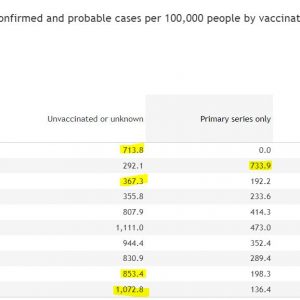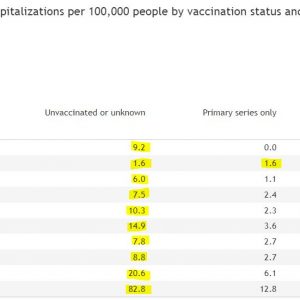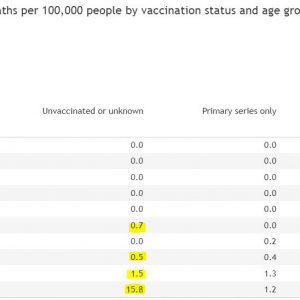Vaccine Studies Failed to Predict Real-World Outcomes, DHS Acknowledges
Experts continue to push vaccines and boosters all the same
State’s Chief Medical Officer calls reality “biased,” prefers the studies
Vaccinated children at the highest risk for contracting Covid for four months straight
July 27, 2022 | MacIver News Service
By Bill Osmulski
For the past four months, data from the Wisconsin Department of Health Services (DHS) has consistently shown vaccinated children (aged 5-11) are at a far greater risk of catching Covid-19 than their unvaccinated peers. Despite this alarming and steady trend, DHS and other healthcare professionals continue advising parents to get their children vaccinated.
The FDA first approved the Covid vaccine for emergency use in children ages 5-11 in October 2021. The CDC began recommending the vaccine for children 5 – 11 in November 2021. Wisconsin’s DHS began encouraging parents to get their children vaccinated in November 2021 as well.
Data from the studies looked promising. Pfizer claimed a 90.7% efficacy rate in 5 to 11-year-olds. A CDC study released in March 2022 found the vaccine reduced the risk of infection by 31%.
Soon after that, however, DHS’ monthly Illness After Vaccination reports began showing a disturbing trend. Starting in March, vaccinated children aged 5 – 11 had the highest infection rates out of all age groups and vaccination statuses. They were also 2.4 times more likely to catch Covid as their unvaccinated peers.
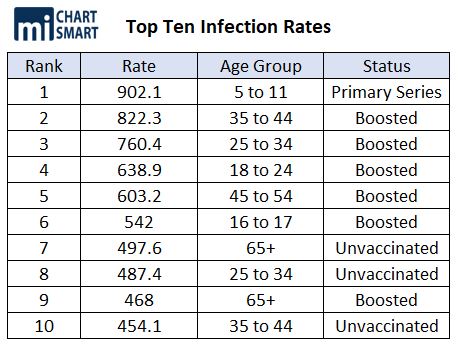
Those results have repeated every month since then. The data from April, May, and June all showed vaccinated children aged 5 – 11 had the highest infection rates, and they were on average 2.4 times more likely to catch Covid than their unvaccinated peers.
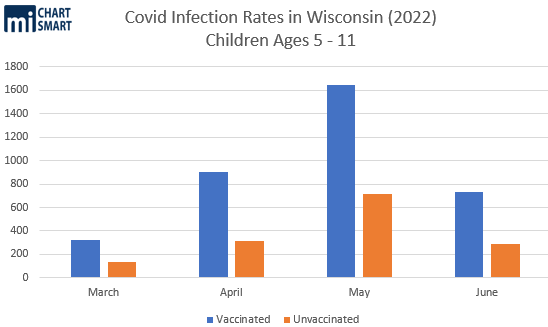
However, this disturbing trend has not changed the advice coming from the professional healthcare establishment.
We recommend the #COVID19 vaccine for everyone 6 months and older. It’s the best way to keep Elmo and all our kids in day care, school, and other everyday activities, whether they be on @sesamestreet or your street. https://t.co/QZrPtDUsgk
— WIDeptHealthServices (@DHSWI) June 29, 2022
Getting your child a #COVID19 vaccine and wondering how to talk about it with them? Dr. Smriti Khare of @childrenswi and @WIAAP has some ‘super-powered” advice.
➡️ Learn more: https://t.co/5LQvDH41Va
➡️ Find vaccine: https://t.co/se6dPR6VRp pic.twitter.com/FU1Z55IYqi— WIDeptHealthServices (@DHSWI) July 5, 2022
Starting in May, DHS included booster status with its monthly report, and another disturbing trend emerged. Vaccinated children ages 5 – 11 still had the highest infection rates, but boosted individuals also showed elevated risks of infection. In six age groups, individuals who received booster shots were more likely than the unvaccinated to catch Covid. Unvaccinated individuals were at the highest risk of infection in only two age groups.
Typically, when test results are different from what happens in the real world, one would conclude something’s wrong with the test. Dr. Westergaard, on the other hand, argued there’s something wrong with reality.
During a press conference that day, Rob Sussman from WTAQ-AM, asked Dr. Ryan Westergaard, Wisconsin’s Chief Medical Officer, why the infection numbers were so much higher among the boosted than those who weren’t vaccinated at all.
The question caught Westergaard by surprise. He had no idea what Sussman was talking about and had to quickly review the data tables. It took some effort for him to locate the table, which is prominently displayed on DHS’ webpage.
Westergaard acknowledged that the infection rates were higher for those who received Covid boosters but argued that doesn’t matter.
“It’s counterintuitive. People who have their primary series and boosters look like they’re being diagnosed more commonly than people that are in the unvaccinated category,” he admitted.
However, “These aren’t the data we look to when we try to answer the question: ‘are vaccines and boosters recommended?’ Those are clinical trials and vaccine efficacy studies. Those data have shown that when you randomize people to vaccine or placebo or booster or no booster, that the risk per person in a well-designed study is lower,” Westergaard explained.
“These are the real data, the real data that we observe, but there is potentially a lot of sources of bias,” Dr. Westergaard said. “The risk per person in a well-designed study is lower.”
Typically, when test results are different from what happens in the real world, one would conclude something’s wrong with the test. Westergaard, on the other hand, argued there’s something wrong with reality.
“These are the real data, the real data that we observe, but there is potentially a lot of sources of bias,” he said.
“People who get boosters and people who do not get boosters are not randomly allocated. They may differ. And people who get boosters may be more likely to go get tested if they develop symptoms. People who get boosted may change their behavior so they are exposed more.”
Nothing has changed since Westergaard made those comments. Experts continue to push vaccines and boosters, while publishing data that undermines those recommendations.
And so, even though vaccinated children aged 5 – 11 consistently suffer from higher Covid infection rates month after month, healthcare professionals and public health officials insist that they all be vaccinated. And, even though the same thing is occurring among the boosted in most age groups, those experts want everyone to get boosted.
Although the studies clearly failed to predict actual public health outcomes, the experts seem to be more committed to those studies than to reality. Equally bizarre, the public continues to trust those experts more than their own experiences.
Dr. Ryan Westergaard from @DHSWI says don’t believe the data and numbers on #COVID19. Just trust the studies and get vaccinated. #WIright pic.twitter.com/ho8qaiFV91
— MacIver Institute (@MacIverWisc) August 20, 2021
